|
Lavochkin La-5
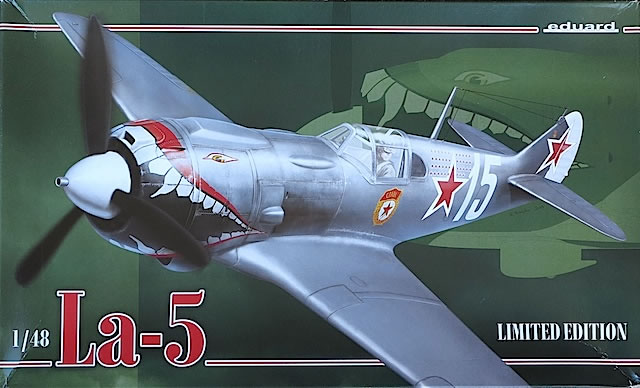
Eduard Limited Edition, 1/48 scale
S
u m m a r y |
| Catalogue Number: |
Eduard Kit No.1184 – La-5 Limited Edition |
| Scale: |
1/72 |
| Contents and Media: |
Approximately 142 grey coloured plastic parts (27 unused); 9 clear plastic parts; 2 grey resin parts; 2 frets of photo-etched brass pieces (1 pre-painted, 1 unpainted); 1 sheet of die-cut tape masks; 1 decal sheet containing markings for 5 aircraft; 12 page full colour instruction booklet. |
| Price: |
USD$42.46 plus shipping available online from Eduard’s website and specialist hobby retailers worldwide |
| Review Type: |
FirstLook |
| Advantages: |
Excellent base kit; photo-etched frets and Brassin wheels provide high levels of extra detail; five interesting and varied marking options. |
| Disadvantages: |
A couple of sinkmarks. |
| Conclusion: |
This release is a good example of Eduard’s Limited Edition philosophy of taking a sound basic kit and making it better by including multiple marking options and photo-etched and other details. Eduard’s reboxing of Zvezda’s sprues will likely remain the definitive 1/48 kit of this influential but under-kitted World War 2 fighter for some time. Highly recommended. |
Reviewed by Brad Fallen

Eduard's Limited Edition 1/48 La-5
is available online from Squadron.com
Essentially a LaGG-3 airframe modified to accommodate a Shvetsov ASh-82 engine, the La-5 was the first in a series of Lavochkin fighters that played a major role in wresting air superiority from the Luftwaffe in the east. The La-5 first flew in early 1942 and was deployed operationally from August the same year. Just under 10,00 La-5s of all types (including La-5UTI trainers and the improved La-5F and La5FN) were built before produced ceased in 1944 in favour of the definitive La-7.
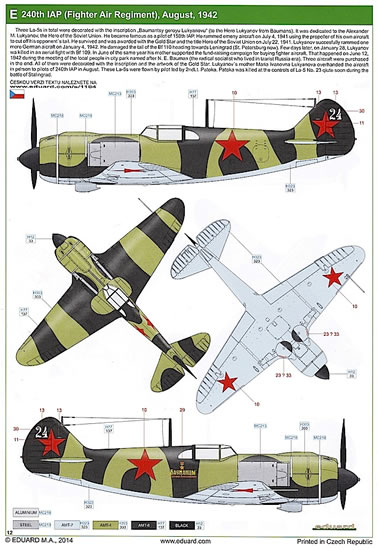
My research suggests that at least six manufacturers have so far produced 1/48 kits of the La-5 family:
- Falcon released a La-5FN vacform kit in the 1980s, which was accurate in outline but lacked interior and other details;
- Hobbycraft’s La-5FN from the same period is reportedly very inaccurate;
- South Front’s injection moulded La-5 from the mid-2000s was also limited run;
- Vector’s excellent resin La-5, La-5F, and La-5FN kits were released in 2006 and 2007 – see Brett’s La-5F review, and also Ian Robertson’s La-5F and La-5 builds;
- Vector’s kits were surpassed in 2007 by Zvezda’s injection moulded La-5FN, with an equally good La-5 following several years later. These kits build into accurate and well-detailed models out of the box, although their complexity and engineering reward patient assembly.
In November 2013, Eduard released Zvezda’s La-5FN kit in a Limited Edition boxing, complete with photo-etched details, Brassin wheels, pre-cut tape masks and Cartograf decals for five aircraft. Brett Green built this kit into a beautiful model earlier this year, and reported a generally trouble free build with the exception of fitting the cowling panels and exhausts.
Now Eduard has repackaged Zvezda’s La-5 sprues into a similar Limited Edition release, with markings for five Soviet machines flown between 1942 and 1944.
Eduard’s box art of Major Georgi Kostylev’s fish-mouthed La-5 makes a dramatic first impression. Profiles of the five marking options are on one of the side panels, while the others show top and bottom views of Kostylev’s machine and images of the Brassin wheels.
Zvezda’s plastic parts are provided on three grey and one clear sprue. The grey sprues were packed together in a single plastic bag (presumably Zvezda’s original packaging), but did not suffer any damage as result.
The parts are well moulded, although not as crisply as a current Eduard or Tamiya kit. The major airframe components are very good, with smooth areas reflecting the largely wooden construction of the airframe along with finely inscribed panel lines and rivets where appropriate. There are a couple of small sink marks on the outside of the forward fuselage halves (opposite internal structures), but these can be rectified with only a little filler. The extensive internal stringer detail has also caused ‘ghosting’ along the back half of both fuselage pieces; I don’t think there are any actual sink marks here, although I won’t know for sure until the parts have been painted.
The highlights of the plastic parts, for me, are the Shvetsov ASh-82 engine and the cowling panels that surround it (although these can be left off to display the engine if you wish). The engine cylinders are beautifully moulded, as are the delicate hinge lines on the upper cowling. Unfortunately the same can’t be said for the pilot’s seat, which has a large and tricky to remove ejector pin mark in the middle of the seat pan. My recommendation would be to fill and then cover this as best you can with the supplied photo-etched seat belts, or use an aftermarket alternative such as BarracudaCast’s excellent 1/48 World War II Russian fighter seat.
This gripe aside, Zvezda has engineered and moulded a very complete cockpit which when combined with Eduard’s pre-painted photo-etched parts should look superb.
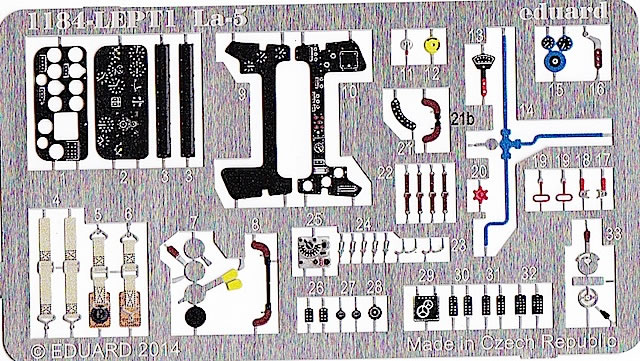
I say ‘engineered’ deliberately because Zvezda has departed from the traditional ‘sandwich the cockpit between the fuselage halves’ approach by designing the cockpit and other internal structures to be assembled on top of the wing; it’s not until well into the construction process that the fuselage halves are slotted into place. This approach looks slightly fraught in the instruction booklet – there are a lot of parts that need to be aligned for it to work – but Brett experienced no real problems when building the similarly engineered La-5FN kit.
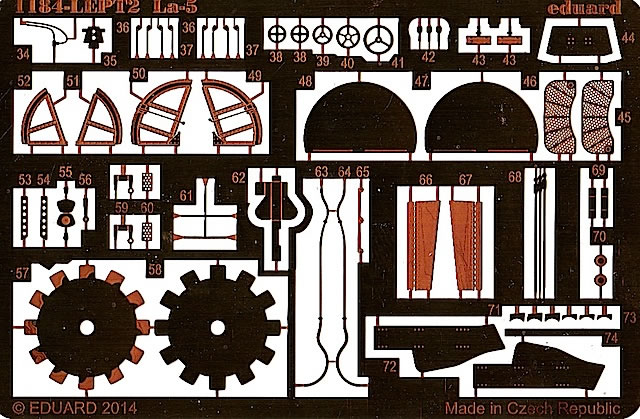
The transparent parts are packaged separately and, while not sparkling on the sprue, should shine up with a dip in Future. The pre-cut tape masks will make painting both the canopy and the wheels significantly easier.
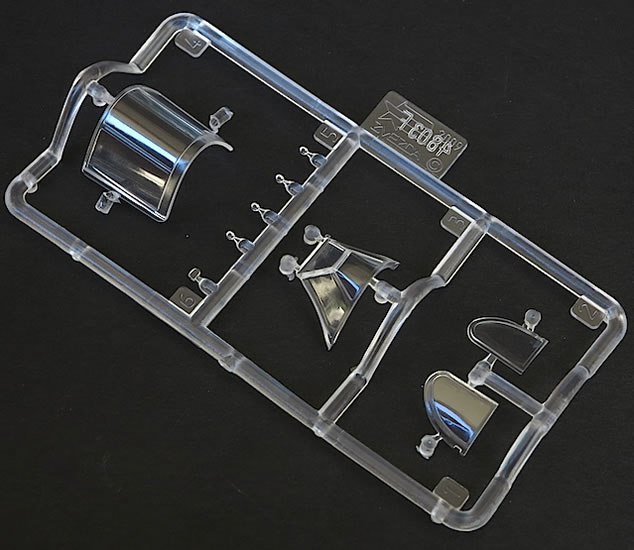
Two Brassin mainwheels replace the kit items. The latter aren’t bad, but they are supplied as halves that must be glued together and so can’t compete with the highly detailed, one piece Brassin wheels. These have been cast unweighted, and designed to be easily removed from their casting blocks.
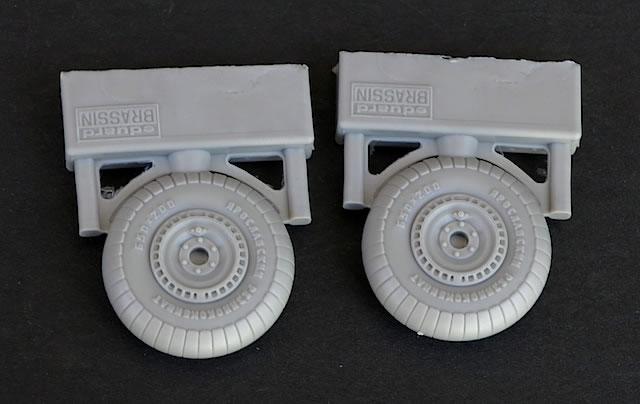
Given the level of detail Zvezda has incorporated into the plastic parts, the two photo-etched frets included in this boxing are icing on the cake. Most of the pre-painted fret goes into the cockpit, while the unpainted fret includes supplementary and/or replacement engine and undercarriage parts.
All this detail is brought together in a full colour, 12 page A4 instruction booklet. The instructions are the busiest I have seen for some time, and you will need to pay careful attention to avoid mishaps during assembly. That said the construction sequence is logically set out, with the placement of photo-etched parts clearly indicated. Gunze-Sangyo paint numbers are used for colour call outs.
Marking Options
The instructions also include full colour four-view painting and marking guides for the five La-5s featured. Decal placement and paint colours (again in Gunze numbers) are clearly indicated.
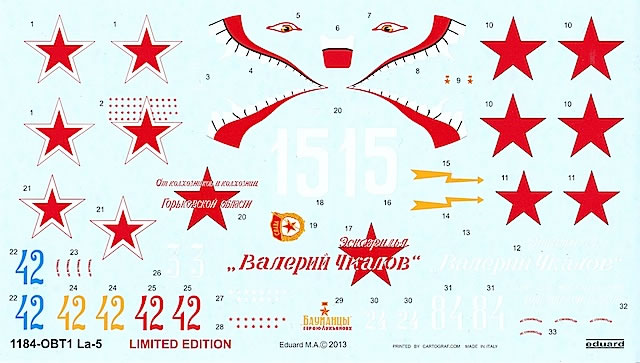
Individual aircraft details are as follows:
-
‘15’, flown by Guards Major Georgi D. Kostylev, 4th Guards Fighter Aviation Regiment (GIAP), Leningrad, Summer 1944. According to the kit instructions, this aircraft was flown only once by Kostylev before it was presented to the Defence of Leningrad Museum. The non-standard upper surface colour is described as a mix of AMT-11 blue grey and AMT-12 dark grey applied over the original green (or green and black) camouflage, while the undersurface was standard AMT-7 greyish-blue. The spectacular fish mouth was reportedly painted on the engine cowls of this and two other La-5s by a unit technician.
-
‘3’, flown by Konstantin A. Novikov, 40th GIAP, Summer 1943. This aircraft along with marking options D and E was camouflaged in AMT-4 green and AMT-6 black over AMT-7.
-
‘42’/‘Eskadrilya Valery Chkalov’, 193rd Fighter Aviation Regiment (IAP), February 1943. The inscription refers to the test pilot Valery Chkalov, who died landing the I-180 prototype in 1939; the machine was purchased with donations by workers from Chkalov’s home town of Gorky. Photographs show the white distemper covering the original AMT-4/AMT-6 upper surface camouflage as almost pristine, suggesting they had been taken soon after the water-soluble distemper was applied. Eduard has provided alternative red, yellow and blue decal options for the number ‘42’ on the fuselage sides, reflecting the inconclusive evidence of period photographs.
-
‘84’/‘Eskadrilya Valery Chkalov’, 88th GIAP, September 1943. Also purchased with donations from Gorky, this La-5 was captured by Germany in 1943.
-
‘24’/‘Baumantsy geroyu Lukyanovu’, 240th IAP, August 1942. This machine was dedicated to Alexander M. Lukyanov – famous for his ramming attacks against Luftwaffe aircraft in the early days of the war – and presented to the 240th IAP by Lukyanov’s mother.
As usual with Eduard’s Limited Edition kits, the decals have been printed by Cartograf and look very good on the sheet. Colour registration and density appears to be fine, even on the smaller decals. The teeth and lips of marking option A are supplied as two separate decals that will need to be carefully positioned on the engine cowlings. Carrier film has been kept to a minimum on these two large decals to help with alignment, but this will also make them trickier to handle – so take your time if you are modelling this aircraft.
This release is another good example of Eduard’s Limited Edition philosophy – that is, taking a sound basic kit and making it even better by including interesting decal options and photo-etched and other details. The La-5 was in widespread squadron service when the Soviet Union began to turn the tables on Germany, and this repackaging of Zvezda’s sprues will likely remain the definitive 1/48 kit of this influential but under-kitted World War 2 fighter for some time.
Highly recommended.
Thanks to Eduard for the sample
Review Text and Images Copyright © 2014 by Brad Fallen
Page Created 27 May, 2014
Last updated
27 May, 2014
Back to HyperScale Main Page
Back to Reviews Page |
